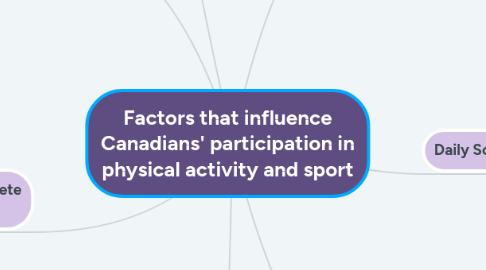
1. Overall Health
1.1. Some Canadians are unable to participate in physical activity due to disease, injuries or other health concerns.
1.1.1. Some Canadians may require a certain amount of physical activity for health reasons (i.e. physio therapy).
1.2. Some Canadians may be more dedicated than others to keeping their bodies healthy and well nourished.
1.2.1. Many Canadians are becoming more physically active to attain the bodies they desire.
1.3. Doctors, physiotherapists or other health professionals recommend daily physical activity for better overall health.
2. Family & Friends
2.1. Loved ones can influence one's physical activity level, whether positively or negatively.
2.1.1. Family members may push other family members into becoming more physically active to improve the individual's health.
2.2. Typically children who grow up in an active household are more likely to continue the same patterns throughout their adult lives.
2.3. People may be encouraged to be more physically active by working out together, playing family team sports, organising outdoor playtime with children, etc.
3. LTAD (Long-term Athlete Development)
3.1. LTAD strives to improve participation in physical activity and organised sports across Canada, resulting in better adult athletes.
3.1.1. Reminds Canadians of the importance of being physically active.
3.2. With the aid of coaches and recreation administrators, the youth are motivated to participate in physical activity.
3.2.1. Athletes may pursue organised sports as an elite athlete or choose to practice a simple active lifestyle.
3.2.2. LTAD is sport driven, sponsored by administrations and sport sciences.
3.3. LTAD is a 7-stage model for athletes to receive structured training and competition in programs that are modified for the chronological and developmental ages of the athlete.
3.3.1. Ensures physical literacy on which active and athletic excellence can be built supporting the four goals of the Canadian Sport Policy; enhanced participation, enhanced excellence, enhanced capacity, and enhanced interaction.
4. Community & Environment
4.1. Some communities have recreational places for active living or cooperative sports organisations.
4.1.1. Many communities and workplaces have gyms available for training.
4.2. Communities in the countryside may offer a variety of outdoor sports and activities.
4.2.1. Not all sports are available in all communities.
4.3. Organised sports typically are available at a price which may not be affordable for some individuals.
4.4. Activities or sports may be located far from home and require individuals to drive as the only mode of transportation.
4.4.1. Many forms of public transportation in communities include buses, cars, taxis, bicycles, ubers, etc.
4.4.1.1. Many schools use buses to transport students and many receive rides from parents or other students.
4.4.1.2. Some communities do not offer buses or taxis due to populations.
5. Media
5.1. The majority of Canadians are influenced by what they see in the media, whether its content such as photos of sports illustrated models or sporting events.
5.1.1. Large televised sporting events such as the Olympics, NHL, NBA, NFL, Fifa, World Cup, etc.
5.2. Social trends play a big role in influencing physical activity.
5.2.1. Celebrities have a large influence on the population and have the tendency to "inspire" others to become more physically active.
5.2.2. Many famous athletes such as Wayne Gretzky, Steve Nash, Marie Phillip-Poulin, have inspired many Canadians to play sports.
6. Daily Schedules
6.1. Many Canadians are becoming more preoccupied with other things than physical activity and find it a last priority.
6.1.1. People may have schedules that conflict with sports which cause the other activity to be prioritised.
6.2. Some Canadians have more than a sufficient amount of time for physical activity.
6.2.1. Parents may register children for more than one sport.
6.3. School, work and other curricular activities result in many hours of the day being spent at a desk.
6.4. Canadians with careers in trades such as construction may not feel the need to be physically active outside of work.
7. School Programs
7.1. Physical Education is mandatory from Preschool to Grade 9.
7.1.1. Phys Ed. from Grades 10-12 are all optional electives and it is the individual's choice to be active.
7.1.1.1. Future career opportunities may motivate individual students to further their physical active lifestyle at school or outside of school.
7.2. The Government tries to promote Phys Ed. for a lifelong healthy lifestyle.
7.2.1. All schools within Canada must promote healthy active living to students of all ages.
7.2.2. Phys Ed. programs reduce child obesity rates and keep children healthy and active. Children are motivated to be active and are taught physical literacy.

